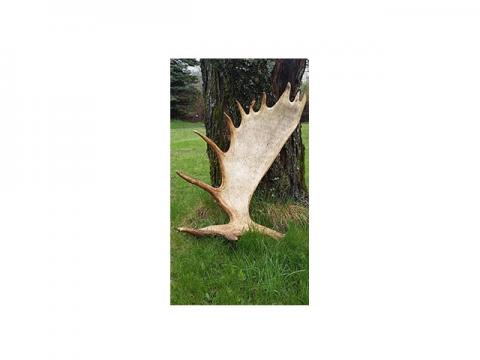Looking for Moose Antlers

Now that the snow has finally melted, walks in the woods take me into the higher terrain, looking for moose antlers. This is a popular pastime in moose country, and a great reason to get out into the woods before the leaves emerge.
The best places to find shed moose antlers are where moose spend the winter. These seem to be in higher elevations, where spruce, fir, birch, striped maple, and mountain ash are found. Areas where I’ve found moose overwintering tend to have shorter trees due to the thinner soils, and consist of a natural patchwork of dense trees and openings. Perhaps this mix is what makes the area attractive to moose. The openings have available browse, and the denser areas provide cover from wind and cold temperatures.
While deer gravitate toward dense lowland spruce-fir forests for winter cover, moose like the higher elevations. Moose are certainly better adapted to the more open conditions of the highlands – they can reach higher for browse, and their long legs allow them to navigate deep snow. I remember one winter when the snow was three or four feet deep, watching a moose easily trotting through the snow without much effort. Seeing that made it clear to me why northern New England is moose country – they’re simply adapted to the winter conditions.
Bull moose grow antlers every spring and summer, and then shed them in late fall and winter. The antlers are mainly used during the breeding season, called the “rut”, which is usually around September. The size of a healthy bull’s antlers increases each year until it reaches its prime, then starts to decline as it ages. A large set of antlers signals to younger or weaker bulls that the moose wearing them is not to be messed with. Sometimes equally matched bulls will battle each other, but these infrequent fights are usually brief shoving matches rather than battles to the death. Every once in a great while, bulls’ antlers will be so hopelessly interlocked that they can’t break free and they gradually succumb to starvation.
After the rut is over, bulls typically shed their antlers between November and March. Mature bulls tend to drop theirs first. Carrying large antlers uses more energy, and mature bulls that were active during the rut have low energy reserves, so it makes sense from a survival perspective to lose their antlers before winter. Younger bulls tend to lose their antlers later. One April I saw a bull carrying one antler, and two weeks later I saw him again, still carrying it! He must have been getting tired of feeling lopsided.
When moose drop their antlers, they’re not only leaving a prize for shed hunters to find, they’re also leaving an important source of minerals for rodents. Mice, squirrels, and porcupines chew on antlers for calcium and other minerals, and to keep their teeth filed down. All the more reason for shed hunters to get out in the woods as soon as the snow melts. As the season goes on, it becomes harder to find antlers – not only do the leaves make them harder to see, but the rodents make them disappear.
Another, more concerning, factor has made moose antlers difficult to find. When I worked in northern New Hampshire in the mid-1990s, it was typical to see several moose every week, and sometimes several per day. You had to be very careful driving on the roads at dawn and dusk, especially around swampy areas where they commonly gathered.
The high population was largely a result of widespread improved habitat. In the late 1970s and early 1980s, an insect called spruce budworm devastated many thousands of acres of spruce-fir forest in Maine and the northern regions of New Hampshire and Vermont. Subsequent salvage harvesting resulted in thousands of acres of clearcuts, which quickly grew back to aspen, birch, red maple, and other favorite moose foods. The availability of so much food resulted in a greatly increased moose population. Since no population can expand forever, eventually something reduces the numbers. Given a lack of predators besides humans, and human predation being closely controlled, another, less visible control mechanism stepped in: parasites. Moose host a number of parasites, but the winter tick has caused the most damage. A high moose population, combined with milder winters, created ideal conditions for the tick to thrive. High numbers of ticks (sometimes in the tens of thousands) feeding on a moose cause the animal to lose a lot of blood, and as the winter progresses, the affected moose will rub off a lot of hair. Blood loss weakens the moose, and combined with hair loss often leads to the moose’s death by exposure. Calves are particularly vulnerable, and where it was once common to see a cow with twin yearlings, it’s now common to see a cow with no yearlings come spring, or at best a single calf.
Despite the devastation wrought by the winter tick, moose populations still persist. Early reports from New Hampshire say that calf survival is higher this year. In the northern parts of the state, snow fell and stayed earlier than recent years. Once snow falls, the ticks stop attaching to moose. The longer it takes for snow to arrive, the longer time the ticks have to attach to a host moose. Earlier snowfalls give the moose more of a chance. And as moose numbers decline, tick numbers should decline as well. Central and southern New England is at the southern end of moose range; since winters are milder the further south you go, the more susceptible moose will be to ticks. But even as far south as Massachusetts, moose are still holding on. My parents recently had a moose in their backyard in north central Massachusetts, and from the pictures they showed me, it looked fairly healthy.
Like all wildlife, moose populations will continue to respond to habitat conditions, predation, parasites, and diseases. As long as suitable habitat is available, moose populations will survive.
Though fewer moose makes it more difficult to find shed antlers, they’re still there for those who put in the effort to look for them. And it’s still a great reason to get into some of the more remote areas where moose, and many other fascinating animals, like to live.
